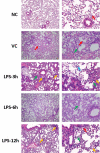The effect of N6-methyladenosine (m6A) factors on the development of acute respiratory distress syndrome in the mouse model
- PMID: 35263199
- PMCID: PMC8973778
- DOI: 10.1080/21655979.2022.2049473
The effect of N6-methyladenosine (m6A) factors on the development of acute respiratory distress syndrome in the mouse model
Abstract
Acute respiratory distress syndrome (ARDS) can cause loss of alveolar-capillary membrane integrity and life-threatening immune responses. The underlying molecular mechanisms of ARDS remain unclear. N6-methyladenosine (m6A)-RNA modification plays an important part in many biological processes. However, it is not clear whether ARDS alters RNA methylation in lung tissue. We tried to investigate the changes of m6A-RNA methylation in lung tissues of lipopolysaccharide (LPS)-induced ARDS mice. Lung tissue samples were collected to detect the expression of m6A factors through hematoxylin and eosin (HE) staining, quantitative reverse transcriptase-polymerase chain reaction (qRT-PCR), immunohistochemical analysis and western blot. The overall m6A levels in lung tissue of ARDS in mouse were detected by UPLC-UV-MS. HE staining showed that the degree of the inflammatory response was more severe in the LPS-3 h group. The mRNA expression of YTHDF1, YTHDC1 and IGFBP3 was remarkably up-regulated at, respectively, 6, 6 and 12 h after LPS treatment. The mRNA expression of METTL16, FTO, METTL3, KIAA1429, RBM15, ALKBH5, YTHDF2, YTHDF3, YTHDC2 and IGFBP2 was significantly down-regulated at 24 h after LPS treatment. The protein expression of METTL16 and FTO increased, YTHDC1, IGFBP3 YTHDF1 and YTHDF3 showed a down-regulation trend after LPS induction. Overall m6A-RNA methylation levels were significantly increased at 6 h after LPS induction. In ARDS mice, LPS-induced m6A methylation may be involved in the expression regulation of inflammatory factors and may play important roles in the occurrence and development of lung tissue. It is suggested that m6A modification may be a promising therapeutic target for ARDS.
Keywords: Acute respiratory distress syndrome; RNA methylation; inflammatory response; lung; m6A.
Conflict of interest statement
No potential conflict of interest was reported by the author(s).
Figures








Similar articles
-
The potential role of RNA N6-methyladenosine in primary Sjögren's syndrome.Front Med (Lausanne). 2022 Nov 16;9:959388. doi: 10.3389/fmed.2022.959388. eCollection 2022. Front Med (Lausanne). 2022. PMID: 36465909 Free PMC article.
-
Association of N6-methyladenosine readers' genes variation and expression level with pulmonary tuberculosis.Front Public Health. 2022 Aug 22;10:925303. doi: 10.3389/fpubh.2022.925303. eCollection 2022. Front Public Health. 2022. PMID: 36072379 Free PMC article.
-
METTL3-m6A methylation inhibits the proliferation and viability of type II alveolar epithelial cells in acute lung injury by enhancing the stability and translation efficiency of Pten mRNA.Respir Res. 2024 Jul 15;25(1):276. doi: 10.1186/s12931-024-02894-z. Respir Res. 2024. PMID: 39010105 Free PMC article.
-
The potential role of RNA N6-methyladenosine in Cancer progression.Mol Cancer. 2020 May 12;19(1):88. doi: 10.1186/s12943-020-01204-7. Mol Cancer. 2020. PMID: 32398132 Free PMC article. Review.
-
Function and clinical significance of N6-methyladenosine in digestive system tumours.Exp Hematol Oncol. 2021 Jul 10;10(1):40. doi: 10.1186/s40164-021-00234-1. Exp Hematol Oncol. 2021. PMID: 34246319 Free PMC article. Review.
Cited by
-
Implication of m6A Methylation Regulators in the Immune Microenvironment of Bronchopulmonary Dysplasia.Biochem Genet. 2024 Dec;62(6):5129-5143. doi: 10.1007/s10528-024-10664-1. Epub 2024 Feb 23. Biochem Genet. 2024. PMID: 38393623
-
Role and regulators of N6-methyladenosine (m6A) RNA methylation in inflammatory subtypes of asthma: a comprehensive review.Front Pharmacol. 2024 Jul 23;15:1360607. doi: 10.3389/fphar.2024.1360607. eCollection 2024. Front Pharmacol. 2024. PMID: 39108751 Free PMC article. Review.
-
METTL Family in Healthy and Disease.Mol Biomed. 2024 Aug 19;5(1):33. doi: 10.1186/s43556-024-00194-y. Mol Biomed. 2024. PMID: 39155349 Free PMC article. Review.
-
Effects of microRNA-101-3p on predicting pediatric acute respiratory distress syndrome and its role in human alveolar epithelial cell.Bioengineered. 2022 May;13(5):11602-11611. doi: 10.1080/21655979.2022.2070583. Bioengineered. 2022. PMID: 35506305 Free PMC article.
-
Recruitment of PVT1 Enhances YTHDC1-Mediated m6A Modification of IL-33 in Hyperoxia-Induced Lung Injury During Bronchopulmonary Dysplasia.Inflammation. 2024 Apr;47(2):469-482. doi: 10.1007/s10753-023-01923-1. Epub 2023 Nov 2. Inflammation. 2024. PMID: 37917328 Free PMC article.
References
-
- Bellani G, Laffey JG, Pham T, et al. Epidemiology, Patterns of Care, and Mortality for Patients With Acute Respiratory Distress Syndrome in Intensive Care Units in 50 Countries. Jama. 2016;315(8):788–800. - PubMed
-
- Vincent JL, Sakr Y, Ranieri VM.. Epidemiology and outcome of acute respiratory failure in intensive care unit patients. Crit Care Med. 2003;31(Supplement):S296–9. - PubMed
-
- Tomashefski JF Jr. Pulmonary pathology of acute respiratory distress syndrome. Clin Chest Med. 2000;21(3):435–466. - PubMed
-
- Ranieri VM, Rubenfeld GD, Thompson BT, et al. Acute respiratory distress syndrome: the Berlin Definition. Jama. 2012;307(23):2526–2533. - PubMed
MeSH terms
Substances
LinkOut - more resources
Full Text Sources
Other Literature Sources
Miscellaneous
